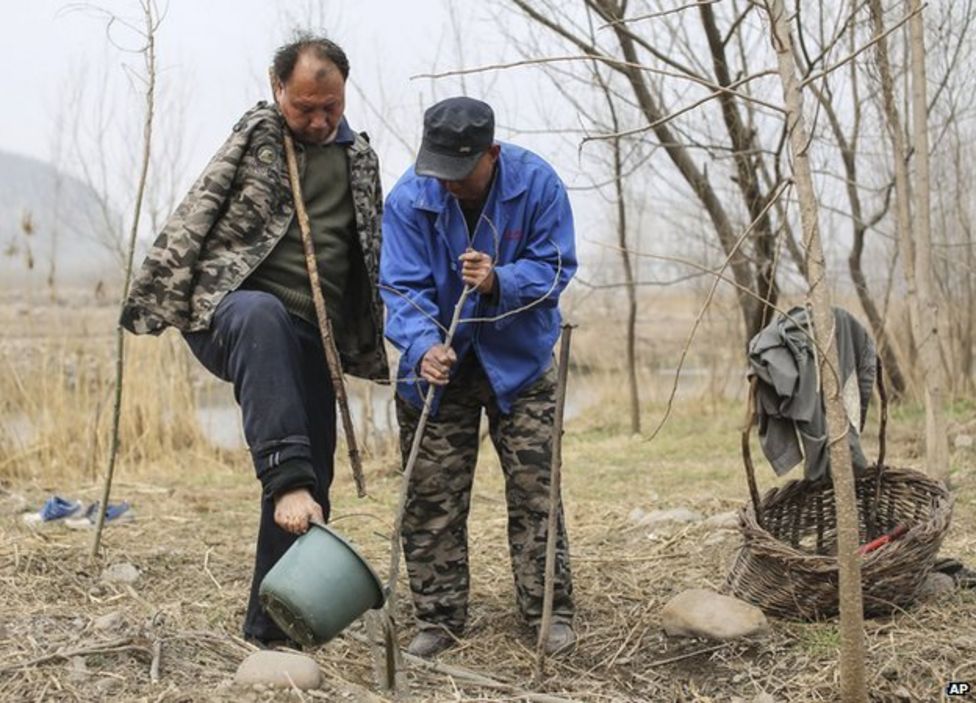The Blind Man and the Armless Man Who Planted 10,000 Trees
In the northeastern part of China, you’ll find a rural village called Yeli. (Here’s a map.) The Ye River — a relatively small waterway — runs near the village, and if you went to one of the local riverbanks two decades ago, you would have come across a barren wasteland, one prone to floods that would often cause damage to the neighboring village. Today, that same riverbank is home to thousands of trees and visiting wildlife. It’s an ecological miracle, one with a unique explanation:
A blind man and a man with no arms needed a way to make a living.

In 2000, Jia Haixia, pictured above right, lost vision in one of his eyes in an accident at the factory he was working at. For Haixia, this was a crippling injury; he was born with a cataract in his other eye, and due to the factory accident, was now fully blind. One of his best friends, though, understood. Jia Wenqui, above-left, lost both of his arms at age three — as the BBC reported, “he touched an unprotected electric cable lying on the ground and received a high voltage shock,” requiring a double amputation — and had learned how to make a living for himself. According to the AP, “he performed for many years in a traveling troupe of disabled people in which he demonstrated calligraphy written with his feet,” and per other sources, managed to use other tools with his head, chin, and shoulders. But in 2001, Wenqui returned to Yeli to take care of his ailing father and reconnected with Haixia.
As Global Times reported, Haixia was living in poverty, and Wenqui approached him with an idea. Wenqui had experience planting trees, and the riverbank was a “wasteland” of nothing more than “cobblestone and sand.” The two signed a contract with the local village giving the duo permission to plant trees without having to pay the village a fee. Any trees the pair successfully nurtured would become theirs to chop down and sell — the contract, per Global Times, noted that “the income from the trees will go to the growers.” As Haixia told Great Big Story (that’s a 2 minute, 46 video, and you should watch it), “I am his hands, he is my eyes,” and the two got to work.
A decade or so later, their efforts started to yield incredible results. By 2015 or so, the wasteland was covered in 10,000 trees that they planted. It wasn’t an overnight success — hardly. As Global Times notes, “The first year they planted more than 800 trees but all except two died during a drought. To get branches as saplings from big trees, armless Jia Wenqi had to squat down to let Jia Haixia climb the tree from his back. And they used to be scolded a lot when they had to get branches from trees in other villages.” But persistence and teamwork paid off.
Along the way, though, Haixia and Wenqui discovered two things: fame, and then, environmentalism. After news of their achievement spread, so did money — all sorts of people and charitable organizations chipped in to help them not only pay their bills but also carry forward with their reforestation efforts. And then, the pair began to realize that they had made an impact well beyond their intentions. The trees helped prevent their village from flooding, reduced the amount of pollution in the region’s air, and brought birds and other wildlife to the area. While they still plan to cut down some of the trees later in life and sell the lumber, they also know that they’ve done well for not only themselves but for their community. As Wenqui told GoPro to close a 10+ minute mini-documentary about them and their efforts, “so let the generation after us, and everyone else, see what two handicapped individuals have accomplished. Even after we’re gone, they will see that a blind man and an armless man have left them a forest.”
Bonus fact: In 1997, an orange juice company called Del Toro came to an agreement with the Costa Rican government — as Princeton University explained, “if Del Oro would donate part of its forested land to the Área de Conservación Guanacaste, the company could deposit its orange peel waste for biodegradation, at no cost, on degraded land within the park.” A competitor sued claiming that the land grant ran afoul of Costa Rican law and won, but not before Del Oro dumped 12,000 tons of orange peels into part of the national park. Given the waste, everyone kind of avoided that area for sixteen years, figuring nothing would happen. But when researchers came back to check on it, they found something incredible had happened — the orange peels had reinvigorated the landscape. Princeton continued: “The area fertilized by orange waste had richer soil, more tree biomass, greater tree-species richness, and greater forest canopy closure.” The orange peels had reinvigorated the landscape.
From the Archives: Circus Trees: Trees designed to look cool.
